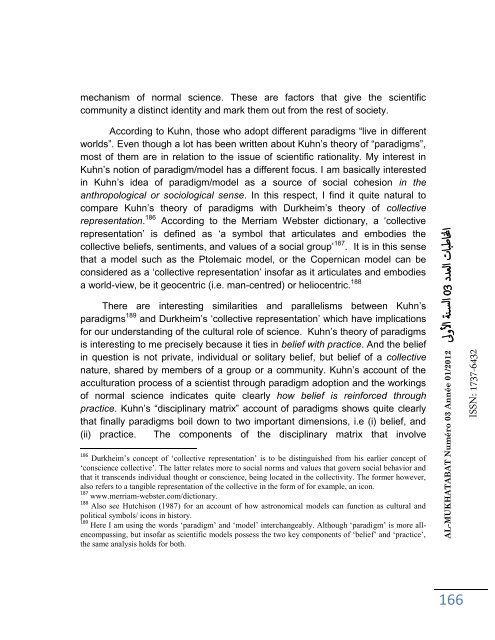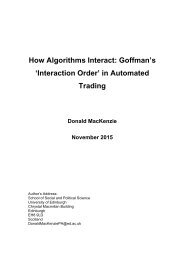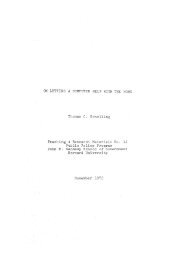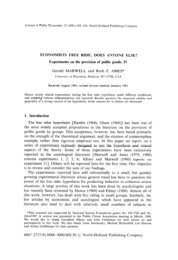n3-al-mukhatabat-journal
n3-al-mukhatabat-journal
n3-al-mukhatabat-journal
You also want an ePaper? Increase the reach of your titles
YUMPU automatically turns print PDFs into web optimized ePapers that Google loves.
mechanism of norm<strong>al</strong> science. These are factors that give the scientific<br />
community a distinct identity and mark them out from the rest of society.<br />
According to Kuhn, those who adopt different paradigms “live in different<br />
worlds”. Even though a lot has been written about Kuhn’s theory of “paradigms”,<br />
most of them are in relation to the issue of scientific ration<strong>al</strong>ity. My interest in<br />
Kuhn’s notion of paradigm/model has a different focus. I am basic<strong>al</strong>ly interested<br />
in Kuhn’s idea of paradigm/model as a source of soci<strong>al</strong> cohesion in the<br />
anthropologic<strong>al</strong> or sociologic<strong>al</strong> sense. In this respect, I find it quite natur<strong>al</strong> to<br />
compare Kuhn’s theory of paradigms with Durkheim’s theory of collective<br />
representation. 186 According to the Merriam Webster dictionary, a ‘collective<br />
representation’ is defined as ‘a symbol that articulates and embodies the<br />
collective beliefs, sentiments, and v<strong>al</strong>ues of a soci<strong>al</strong> group’ 187 . It is in this sense<br />
that a model such as the Ptolemaic model, or the Copernican model can be<br />
considered as a ‘collective representation’ insofar as it articulates and embodies<br />
a world-view, be it geocentric (i.e. man-centred) or heliocentric. 188<br />
There are interesting similarities and par<strong>al</strong>lelisms between Kuhn’s<br />
paradigms 189 and Durkheim’s ‘collective representation’ which have implications<br />
for our understanding of the cultur<strong>al</strong> role of science. Kuhn’s theory of paradigms<br />
is interesting to me precisely because it ties in belief with practice. And the belief<br />
in question is not private, individu<strong>al</strong> or solitary belief, but belief of a collective<br />
nature, shared by members of a group or a community. Kuhn’s account of the<br />
acculturation process of a scientist through paradigm adoption and the workings<br />
of norm<strong>al</strong> science indicates quite clearly how belief is reinforced through<br />
practice. Kuhn’s “disciplinary matrix” account of paradigms shows quite clearly<br />
that fin<strong>al</strong>ly paradigms boil down to two important dimensions, i.e (i) belief, and<br />
(ii) practice. The components of the disciplinary matrix that involve<br />
186<br />
Durkheim’s concept of ‘collective representation’ is to be distinguished from his earlier concept of<br />
‘conscience collective’. The latter relates more to soci<strong>al</strong> norms and v<strong>al</strong>ues that govern soci<strong>al</strong> behavior and<br />
that it transcends individu<strong>al</strong> thought or conscience, being located in the collectivity. The former however,<br />
<strong>al</strong>so refers to a tangible representation of the collective in the form of for example, an icon.<br />
187<br />
www.merriam-webster.com/dictionary.<br />
188<br />
Also see Hutchison (1987) for an account of how astronomic<strong>al</strong> models can function as cultur<strong>al</strong> and<br />
politic<strong>al</strong> symbols/ icons in history.<br />
189<br />
Here I am using the words ‘paradigm’ and ‘model’ interchangeably. Although ‘paradigm’ is more <strong>al</strong>lencompassing,<br />
but insofar as scientific models possess the two key components of ‘belief’ and ‘practice’,<br />
the same an<strong>al</strong>ysis holds for both.<br />
AL-MUKHATABAT Numéro 03 Année 01/2012 لىولأا ةن سلا 30 ددعلا تابطانا<br />
166<br />
ISSN: 1737-6432







